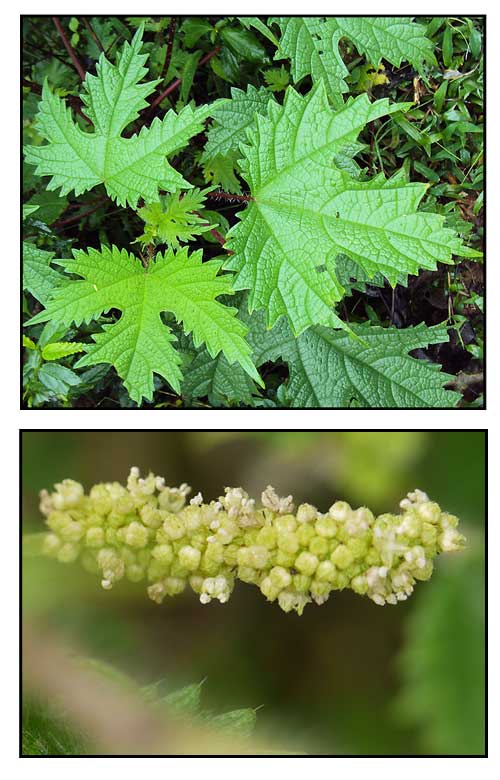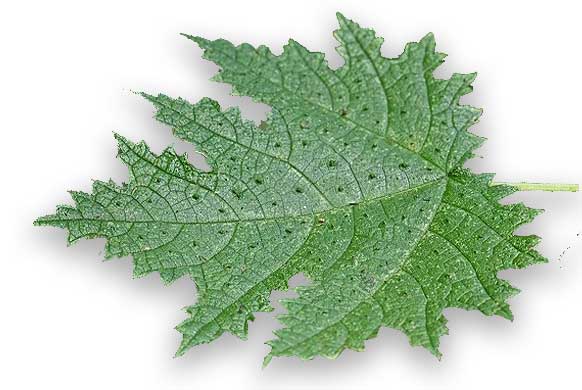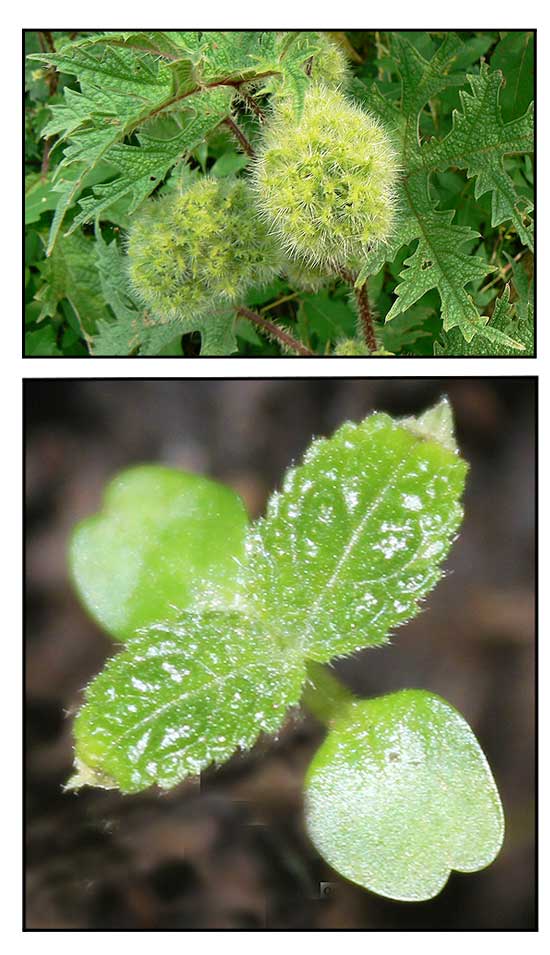 Gen info Gen info
- Girardinia is a genus of flowering plants in the family Urticaceae. There are two known species: Girardinia diversifolia and G. bullosa (Hochsst. ex Steud.) Wedd.
- Etymology: The genus name Girardinia honors Jean Pierre Louis Girardin (1803-1884), a French agricultural chemist and professor in Rouen and Lille. (3)
Botany
• A shade tolerant, tall, stout and erect herb growing to 1.5 to 3 meters height with perennial rootstock. The plant grows as a clump, and each clump has many stems. The stem contains bast fiber of unique quality which is strong, smooth and light. (4)
• An erect annual or short-lived perennial, 1.5(-2) m tall, monoecious or dioecious; stem sparsely branched, covered with stinging hairs 7-9 mm long and with short stiff hairs. Leaves alternate; stipules linear-lanceolate, fused for over four-fifths of their length; petiole 3-15 cm long; blade variously lobed or divided, 10-20(-25) cm × 10-18(-23) cm, base cuneate, truncate or cordate, margin dentate, apex acuminate. Inflorescence unisexual, cylindrical; male inflorescence a narrow, spicate panicle; peduncle up to 2 cm long; flowers on a 1 mm long pedicel, perianth 4-5-merous; female inflorescence a dense cymose, small dichasium 2-3 cm long at anthesis, elongating to 10-15 cm long in fruit. Fruit an ovoid to subcordate achene, compressed.  (6)
Distribution
- Native to the Philippines. (1)
- In Luzon: Mountain province; Mindanao: Cotobato. (1)
- Also native to
Angola, Assam, Bangladesh, Burundi, Cameroon, China North-Central, China South-Central, China Southeast, DR Congo, East Himalaya, Eswatini, Ethiopia, Guinea, India, Inner Mongolia, Ivory Coast, Jawa, Kenya, Korea, Laos, Lesser Sunda Is., Liberia, Madagascar, Malawi, Manchuria, Mozambique, Myanmar, Nepal, Nigeria, Northern Provinces, Pakistan, Primorye, Rwanda, Sri Lanka, Sudan-South Sudan, Sulawesi, Sumatera, Taiwan, Tanzania, Thailand, Tibet, Uganda, Vietnam, West Himalaya, Yemen, Zambia, Zimbabwe. (2)
- Cultivated as a fiber plant in South India. (4)
 Constituents Constituents
- Phytochemical analysis showed presence of phytosterols, fatty acids, carotenoids, polyphenols, and saponins. Most abundant secondary metabolites were ß- and γ-sitosterol (11 and 9% dw, respectively), and trans syringin (0.5 mg/g)
was the most abundant phenolic. Also present were fatty acids with abundant unsaturated derivatives (linoleic and linolenic acid at 22.0 and 9.7 mg/g respectively), vitamin C (2.9 mg/g) and vitamin B2 (0.12 mg/g). (see study below) (7)
- Phytochemical screening revealed phytosterols and triterpenes along with ß-sitosterol,
γ-sitosterol, campesterol, fucosterol, and sitostanol. (see study below) (8)
- Phytochemical studies of roots and stems revealed saponins, tannins, and cardiac glycosides with absence of alkaloids and anthracene glycosides. Chromatographic fractionation of petroleum ether root extract yielded four crystalline compounds, three of which were identified as ~sitosterol, 3-hydroxystigmast-5-en-7-one, and 7-hydroxysitosterol. (see study below) (9)
- Study of roots isolated completion, (see study below) (10)
Properties
- Caution: Like many other nettles in the family Urticaceae, the leaves have stinging hairs; in this species, they are potent, and can give an extremely painful rash and swelling which can last for a week or more. Â (4)
- Studies have suggested antioxidant, anticholinesterase, anti-tyrosinase, a-amylase and α-glucosidase inhibitory, anticancer, antibacterial, antifungal, UV protective, antidiabetic properties.
Parts used
Leaves.
 Uses Uses
Edibility
- Leaves after removing stings are cooked as vegetable in the western Himalaya. (6)
- Young leaves, inflorescences, and roasted seeds reported as edible.
- Stinging hairs are neutralized by heat making cooked leaves safe to eat.
- Topmost bud is edible, prepared as vegetable curry.
Folkloric
- No reported folkloric medicinal use in the Philippines.
- In Nepal, juice, ash, and paste of whole plant, roots, and leaves used for treatment of eczema, worms, gastric maladies, headache, and fever. (15)
- Tribes of Thiashola, Manjoor, Western Ghats, use roots and leaves as stimulant and for treatment of headache, swollen joints, and fever. (17)
Others
- Cordage and textile: In India and Nepal, the shiny wool-like bast fiber from young stems is made into cordage and coarse textiles, sometimes blended with ramie (Boehmeria nivea), cotton, or wool. (6) In Nepal, plant is source of fiber (puwa) for weaving ropes, thread, porter's tumplines, mats, sacks, and bhangra (traditional Gurung clothing). (11)
- Fiber: Fiber is extracted by stripping the bark off the stem, then washed or scraped until the fiber is clean. Alternatively, the stripped-off bark is dried, and the fiber freed by pounding, then boiled with an alkaline solution made from wood ash, then washed until clean. Indian fiber contains 7% moisture and 90% holocellulose. In Indo-China in the 1940s, the bark has been reported to yield 61% fiber. Rough bark strips contained 16% moisture, 38% cellulose, 8% hemicelluloses, 8% lignin, and 7% ash. The fiber is of good quality, but the presence of irritating hairs on all plant parts makes handling unpleasant. (6)
- Fish poison: Seeds used as fish poison in north-eastern India. (6)
- Ethnoveterinary: In eastern Nepal, spines of the Himalayan nettle are believed to stimulate milk production. If cows and buffaloes are not lactating, they are believed to be possessed and are beaten with the nettles to make them lactate. (16) In Uttar Pradesh Himalaya, plaster made from roots and leaves applied on fractures of cattle and goats. (19)
- Superstitions and ritual: Thangmi shamans in Nepal beat humans believed to be possessed by evil spits in the belief it will end the possession. Himalayan nettle should not be touched or eaten by family members of a deceased person on the day of death. If the deceased is one's mother or father, the prohibition is for a whole years. Slightly dried leaves given to female cattle for smooth delivery.(16)
- Others: Also used as fodder, fuel wood, and as live fence.
Studies
• Biological Activities / Neutraceutical, Pharmaceutical, Cosmeceutical Applications: Study evaluated G. diversifolia extracts for potential pharmaceutical, cosmetic, and nutraceutical uses. Study showed moderate antioxidant activity and significant ability to inhibit acetyl-cholinesterase (AChE), butyrylcholinesterase (BuChE), tyrosinase, α-amylase and α-glucosidase. Cytotoxic effect was observed on human ovarian, pancreatic and hepatic cancer cell line. Effect on hepatocarcinoma cells was associated with downregulation of low-density lipoprotein receptor (LDLR), a regulator of cellular cholesterol homeostasis. (7)
• Antimicrobial Activities: Study evaluated Girardinia diversifolia extracts for antimicrobial activity using agar dffusion method. All tested extracts exhibited varying antibacterial activity against Bacillus pumilus, Staphylococcus aureus and Escherichia coli. Only the ethyl acetate extract exhibited significant activity against Aspergillus niger and Candida albicans. (see study above) (9)
• Scopoletin / Roots: Study of roots isolated scopoletin. Scopoletin is a chemical compound of the coumarins group. Review of studies revealed biologic activities such as antitumor, anticholinesterase, antithyroid, antioxidant, antihyperglycemic, and anti-inflammatory. (10)
• UN Protective Textile: Himalayan nettle has been traditionally used for making various fiber-based products. UV radiation causes various skin problems including skin cancer. Study evaluated the fabric properties of woven fabric made of Himalayan nettle fiber for new end uses to protect the skin from harmful UV radiation. Results suggested the properties of nettle woven fabric like thickness, weight, thread count, and cover factor affected the UOF (Ultraviolet Protective Factor) of the nettle fabric. The UV protection properties of the woven fabric could be further enhanced through weave variation. The ultraviolet protection properties has potential for utilization for different UV protection products such as curtains, blinds, and jackets. Further natural dyeing of developed fabric may maximize the UV protective properties of the fabric. (12)
• Antidiabetic / Leaves: Study evaluated the effect of leaves extract of G. diversifolia on fasting blood sugar levels and serum biochemical analysis in alloxan-induced diabetic Wistar albino rats. Results showed significant antihyperglycemic effects in the rats. The alcoholic extract showed good antidiabetic activity compared to the aqueous extract. Further studies advised for isolated of antidiabetic components and mechanism of activity. (13)
• Antiulcer / Stem and Leaf: In a study of ethanolic extract of 8 medicinal plants for pharmacologic activity, Ethanolic leaf and stem extract of Girardia diversifolia was one of five that significantly reduced gastric lesions in the ethanol-induced ulcer model at dose of 500 mg/kg, with greater gastric protection than standard drug, sucralfate (100 mg/kg). Acute toxicity study showed no morbidity, mortality, and toxicity at 2000 mg/kg. (14)
Availability
- Wild-crafted. |

![]()



 Gen info
Gen info
 Uses
Uses